#counterphobia
Explore tagged Tumblr posts
Photo

“I am fascinated by natural forms and their order resulting from geometry, mechanics and physical tension. To logical structure/cosmos, I add feeling/chaos. A permanent sense of loss is a fundamental emotion that drives me.. and beauty is equivalent to a loss- freezing of moments in sculpture is a way to trick time and postpone the inevitable.” The emotive and expressive sculptures created by @goornicki.tomasz touch our hearts and souls. This piece highlights ‘counterphobia’ that leads to actively seeking out anxiety- and fear-inducing situations instead of avoiding them. — #beautifulbizarre #tomaszgornicki #sculpture #artist #sculptor #art #figurativeart #counterphobia #mentalhealth #newcontemporary #contemporaryart #contemporarysculpture https://www.instagram.com/p/CoFM_G3I0ha/?igshid=NGJjMDIxMWI=
#beautifulbizarre#tomaszgornicki#sculpture#artist#sculptor#art#figurativeart#counterphobia#mentalhealth#newcontemporary#contemporaryart#contemporarysculpture
47 notes
·
View notes
Text
Anyways, so. There’s the Insomniac Trio in the Gymrat!AU, right? The twins and Virgil.
Somehow got to rambling about truffle fries one of my local restaurants serves with the co-conspirator. VERY generous portion size for one person. And typically and without fail, they’ve caused carb-overload somnolence like nobody’s business.
And I thought, “What if these three dorks have resorted to just binging on way WAY too many fries as a means of “self-medication”?“
And then thinking Patton would be there going, “Kiddos. Do you WANT to get diabetes?“
Aaand also the fact Remus having PCOS puts him in a high risk group to get diabetes as it is... tho the co-conspirator balked about adding more shit to this man’s health plate as it is.
But like, diabetes sucks but it’s something a lot of people just... live with. Like many other chronic illnesses.
#sanders sides#remus sanders#roman sanders#virgil sanders#patton sanders#food/#(this is just me craving fried food at ungodly hours of the night)#(i would say 'carb coma' but i've grown to acknowledging that that's kind of insensitive)#(oh geez... ro post-ckd dx needs to lay off the salt and i'm just imagining him getting emotional abt that)#(also as a bit of a hypochondriac med nerd... exploring conditions that worry me w/ creative expression... tends to make it less scary?)#(a lot of my love of [body] horror stems from a place of counterphobia and fascination)
2 notes
·
View notes
Note
Mage, would you say all of Dream's problems are caused by his particular brand of Counterphobia?
All would be too strong, but the fact that his instinct was to slam his foot on the gas pedal and visibly act when he got stirred up was definitely a pattern that got him to this point in terms of his reputation. Most people wouldn't know or even think that it's a (half) anxious thing, so he can come off very badly when his mouth/hands are going faster than his brain.
#He's got a very unique blend because it's going to be counterphobia + adhd + trauma history#always a plan to do or fix or move to try and put the energy somewhere#gen drm tag#so glad he's off twitter
1 note
·
View note
Link
Chapters: 1/1 Fandom: 僕のヒーローアカデミア | Boku no Hero Academia | My Hero Academia (Anime & Manga) Rating: Teen And Up Audiences Warnings: No Archive Warnings Apply Relationships: Aizawa Shouta | Eraserhead & Bakugou Katsuki Characters: Aizawa Shouta | Eraserhead, Bakugou Katsuki Additional Tags: Bakugou Katsuki is a Dork, But also, BAMF Bakugou Katsuki, Aizawa Shouta | Eraserhead Needs a Hug, Crack, aspiring underground hero bakugou question mark, tw inconsistent fic tone lmao, very very very mild manga spoilers Series: Part 4 of coffee! Summary:
Shouta stares down at him, feeling distinctly out of his depth.
“This is the worst day of my life,” he says mournfully.
“Thought that was yesterday,” Bakugou hums, apathetic.
“Every day is worse than the last. You’ve exceeded my expectations.”
Bakugou bares his teeth in a shark-like grin.
“Plus ultra, Eraser.”
-
or: aizawa takes bakugou on as an intern. it goes both terribly and phenomenally.
52 notes
·
View notes
Text
Note to self:
Writing techniques? Have I done these?
1. Double up. (Multitasking. . .)
2. Tell the reader about the farmers.
3. No half measures. (Do the whole ass)
4. Delayed emotions. (Do this more often)
5. Funky emotions (you are nothing but f u n k y… time for a shower)
6. Gold coin (pick it up) (I can’t, it’s too fat)
7. Fuck your couch happy ending
———
1. Counterphobia
2. Machiavellian character (me with the ham; me eventually pushing Sephiroth to be like this if I ever continue my bullshit)
3. Gaslighting the reader (tbh this would be fun if I was smart… wait… yes… do it anyway sometime, that’s how you learn)
4. Unsettling tactics
5. Emotional blackmail
6. Red herrings (having just watched that latest Fears to Fathom episode, being able to notice herrings is a good source of omega 3’s)
7. Emotional triggerpoints
8. Unreliable narrator (dunno if I have the audacity but at least I have the cli)
#deletion pending#note to self#something something wetlands read it???#need to remember the guy is John Fox before my YouTube is awash with video game music again#dynamite headdy please calm down
0 notes
Text
Fuck it, cure time
3 notes
·
View notes
Text
“IS SHE BOTHERING YOU QUEEN?” JONES SAYS AS HE IS ABOUT TO BE HURLED ACROSS THE ROOM BY DANNY’S BEST FRIEND, A DEMON
1 note
·
View note
Photo

Counterphobia, n. the fear and/or dislike of seeking a phobic situation rather than avoiding it. #counterphobia #phobic #situation #fearful #phobia #TPhobias
2 notes
·
View notes
Audio
(Counterphobia)
2 notes
·
View notes
Photo

Today’s Topic: Flirting with Disaster. What can “thrill seeking” teach us about animal training? Do you like scary movies, roller coasters, or maybe sky diving sounds appealing? What is it about these experiences that attracts some people but not others? We will also look into possible equivalent animal models and how this might benefit organisms. And finally, we will explore what we can learn from this information that might be applied to our work with animal training. Join me live most every Monday at 11:00 AM Central time for another YOU be the Behavior Consultant. These are interactive events and super fun I might add 😉 with video clips! Everything is now happening in YouTube at this link https://www.youtube.com/BarbaraHeidenreich/ The replay will continue to be posted in the Facebook group Animal Training Fundamentals with Barbara Heidenreich https://www.facebook.com/groups/AnimalTrainingFundamentals/ Come and get your professional development on! #livestream #animaltraining #barbaraheidenreich #zooanimaltraining #exoticanimaltraining #zookeeper #professionaldevelopment #thrillseekingbehavior #sensationseekingbehavior #counterphobia #counterphobicattitude #fearisfun #riskybehavior #areanimalsrisktakers #crowpranksters #spiralcourtship #emotionalcontagion #bondingoverfear #traumabonding #crowbehavior #birdsofpreycourtshipspiral #preyapproachingpredators #talonlocking https://www.instagram.com/p/CdnrBsmutdu/?igshid=NGJjMDIxMWI=
#livestream#animaltraining#barbaraheidenreich#zooanimaltraining#exoticanimaltraining#zookeeper#professionaldevelopment#thrillseekingbehavior#sensationseekingbehavior#counterphobia#counterphobicattitude#fearisfun#riskybehavior#areanimalsrisktakers#crowpranksters#spiralcourtship#emotionalcontagion#bondingoverfear#traumabonding#crowbehavior#birdsofpreycourtshipspiral#preyapproachingpredators#talonlocking
0 notes
Text
I did it. I reached 30 tags.
#i don’t want to make like a full on post about it but anyway anohana typology stuff:#menma: errr infp probably also kind of bland tbh no idea what the people in the wiki were on#also no idea what any of the people who crush on her are doing with their lives wtf but anyway#she’s probably soc dom.... imo?#jintan can uhhh choke ajsjsndnf#he’s probably some IxxP sp dom?? despite skipping classes so much#sp/so i’m guess#probably ixfp#i’ll go with isfp i guess?#tsuruko felt like an infj 1w9 sp/sx#probably 5 fix and 4 fix(?)#1w9 5w4 4w5 i guesz#i guess to some extent i related to her?#i think she’s how i see my one fix in general#or else it doesn’t make sense that i focused so much on her??#poppo is uhh exfx (exfp imo) 7w6 and 2 and 9 fixes in some order probably#he just lacks any semblance of counterphobia i guess... as in he#just not a dick#at all#moving on we have anaru??#no clue but like a fucking mood#clearly soc and i want to say 4 almost?#idk her ennea really escapes me#no idea what her type is though but probably an fi? i guess???#yukiatsu is some ixtj 3w2(?) sp/sx#ok now i found kawaii-mbti’s post and i agree with esfp for poppo bc the food and travel#apparently everyone disagrees with me on tsuruko but hhh anyways#esfj for anaru feels wrong somehow?? idk it might be righf????#i guess it would explain her being relatable#and i guess menma could be enfp i don’t really care either way lol
3 notes
·
View notes
Text
EREN JAEGER AND THE ENNEAGRAM TYPE 6
First of all, to my followers, please excuse me. This account isn’t for SNK but it’s the one I have and I wanted to write this.
Secondly, I hope this post finds the fandom lol. But if you’re expecting this to be another meta to judge Eren’s actions, don’t waste your time. The enneagram is a tool of understanding, not judgement, and I just wanted to share one thing I appreciate immensely about Eren’s characterization.
Well, why don’t we start with chapter 137? There, Zeke states that life’s purpose is to propagate and it’s core fear is to be extinguished. In other words, from the moment we are born, our organisms need to survive. As humans, we are on our own: suddenly, you gotta breathe on your own; the food is no longer provided. Everything is scary. A baby cries because everything is hard and far away and something in their biology tells them to keep fighting to survive.

Now, onto a more spiritual approach. In El Eneagrama de la Sociedad, Claudio Naranjo says that several cultures have their own ideas and tales regarding a disconnection from a primordial state of wholeness. Once born, we become individuals and are separated from the Universe, as if we’re no longer in sync, and something is lost in the process. How can we survive? Our defense mechanisms start with that question. We need love, we need resources and we need to stand our ground in this cruel, but beautiful world. This, on the enneagram, is called “childhood trauma”.
What I want to do in this post is to break down Eren’s character development through the lens of the enneagram, but for that, I need to give you an overview of the system. It is cruel and beautiful, just like the SNK world. It sees us with care and understanding but it also exposes the harsh truths we don’t want to see.

The enneagram, first and foremost, is an ancient symbol, a figure of nine points connected within a circle. There’s a lot of fascinating history to it, but I’m gonna focus on what matters to this post. The enneagram is a personality system that encompasses nine essences of the Universe, and once our childhood trauma sinks in, we attach to one type which defines our worldview. Here’s how each enneatype manifests itself:
Type 1, the reformer: this person seeks to not make mistakes. They are principled and meticulous in everything they do but highly critical of themselves and others.
Type 2, the helper: this person seeks to be needed. They are proud of their independence and helpfulness but believe they can only receive love if they give first.
Type 3, the achiever: this person seeks to be worthy. They are motivated and ambitious but shape themselves around what is expected of them.
Type 4, the individualist: this person seeks to build their identity. They are sensitive and creative but reject the ordinary and focus on what is harder to reach.
Type 5, the investigator: this person seeks to be a specialist. They are perceptive and curious but withhold themselves and their resources and worry they’re never prepared.
Type 6, the loyalist: we’ll talk about it in a moment.
Type 7, the enthusiast: this person seeks to avoid pain. They are joyful and spontaneous but afraid of facing hardships and being swallowed by negativity and sadness.
Type 8, the leader: this person seeks to be strong. They are fierce and protective but don’t allow themselves any vulnerability and need to be on top.
Type 9, the peacemaker: this person seeks to be in peace. They’re kind and their inner stability is unshakable, but have a hard time asserting themselves.
So what does it mean to be a type 6?
Some of you might not believe if I told you that Eren is moved by fear. But that’s what it is. The type 6 represents fear itself. It’s our search for safety and support. The person who is a type 6 has disconnected from their inner guide and they don’t believe they have the same capability to make decisions as everyone else. That is more of an unconscious state, which manifests through an overly alert stance. Sixes are always on the lookout for threats and danger, their minds work predicting things that can go wrong, so they can be prepared. In other words, the type 6 fears how imprevisible life is, because they truly don’t find in themselves the compass to the answers they need “in this very moment”. They have to be one step ahead and they have to find outside structures for support, people in whom to trust and who’ll give them the guidelines and sense of balance. Fellowship and loyalty are essential to the type 6 as they look for reassurance in their concerns.
In Personality Types: Using the Enneagram for Self-Discovery (1996), Don Richard Riso has described nine levels of development for the enneatypes. They are the path from our healthy, healed state where we’re closer to wholeness again (Level 1) down to our most broken state where we’ve abandoned ourselves (Level 9).
When we start Attack on Titan, Eren is on Level 6. Here’s what Riso says:
“In its innocent forms, counterphobia is well employed by people to master their fears — for example, children who are afraid of the dark might purposefully go to a dark room to overcome their fear.”
Eren, too, wanted to overcome his fear since he was a kid. He wanted to go outside and face those faceless titans. He wanted people around him to be prepared, but since the Garrison was incompetent and lazy, he needed to be prepared. Grisha seems to be Eren’s first authority figure. From what we know, Grisha allowed Eren to have his own thoughts and didn’t impose anything on him, which is a kind of reassurance. Thus, with his father, Eren felt more understood.
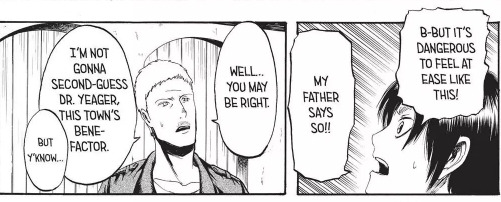
Carla, on the other hand, wished for Eren’s immediate safety and cared about him living a quiet life. But that also means she couldn’t understand his concerns, and the type 6 interprets that demeanor as vulnerability — his mother is more exposed to the threat. If the type 6 is a room where nobody is vigilant, the only option they see is to step up and become hypervigilant.
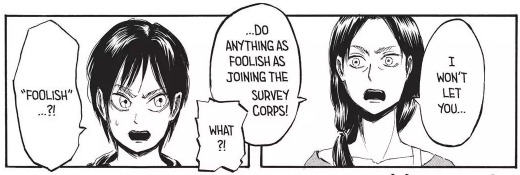
This relation to an authority is very specific for the type 6 as they search for people and systems in whom to rely on. Since the Garrison aren’t the most reliable soldiers around, Eren turns to the Survey Corps. That section of the military consists of the rebels, those who want to explore the unknown, understand the titans and figure out the best way to fight the enemy. The SC wants to be free, so they become Eren’s next “authority figure”.
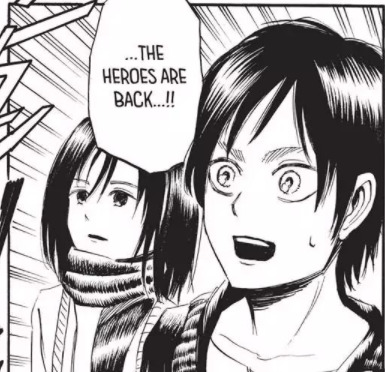
Riso also says that the type 6 in Level 6 has a more aggressive stance and wants to prove to others that he isn’t indecisive and can’t be pushed around.

“They blame and berate whatever threatens them. They become rebellious… and are desperate to latch onto a position or stance that will make them feel stronger and dispel their feelings of inferiority.”
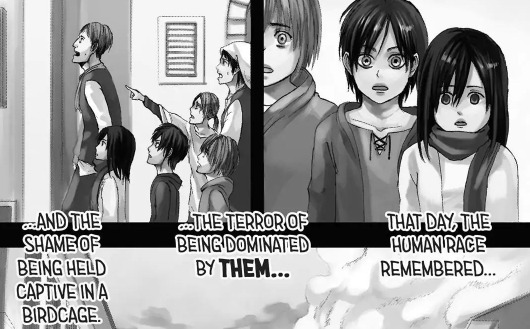
The type 6 feels inferior because they feel lost inside. Eren, too, knows that the threat lurking behind those walls is much bigger than him and a single human doesn’t stand a chance. And he berates people around him for not seeing what he sees, or for disrespecting his “heroes”.
Eren will be back to Level 6 later, embodying other aspects of it, but let’s talk about the moment he joins the army.
At this point, Eren reaches the stable position he has been eager for. He is part of a group and working towards his goals, he feels more confident because he’s preparing for the next attack. He has climbed to Level 4:
“The security which groups and institutions provide far exceeds the strength of any individual members...”
As we know, Eren sees his mission to eradicate all titans also as a social responsibility. The type 6 can easily fall into “us versus them” mentality where they are putting effort into something and will trust only the people who understand the importance of it. Eren’s bickering with Jean, as well as his admiration for Reiner starts from there.
“And even within their own group, average Sixes make it their business to find out who is pulling the weight and who is not... If others are not loyal or committed, it not only makes them angry, it threatens them.”
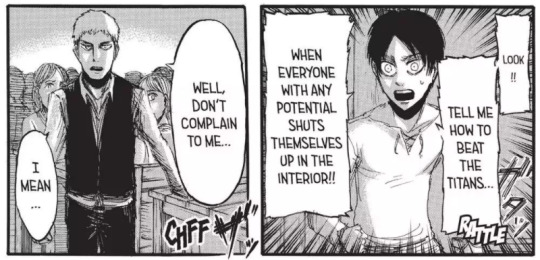
Eren talks over and over about how he’s going to join the suicide squad, to the point people start making fun of him. But he is testing everyone’s commitment to the cause of “fighting titans” and he finds people like Jean, who only really want their safe life, as well as Reiner, who is dedicated and understands him immediately. Reiner becomes his new “authority figure”: whenever Eren’s failing, Reiner is there to understand him, to offer help and to remind him of why he’s there.

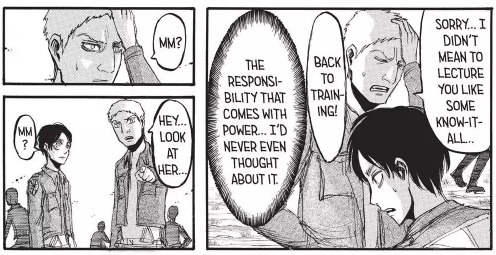
“The loyalty of average Sixes for the people with whom they have identified is almost without bounds. They find it extremely difficult to break their emotional bonds, even should they desire to do so… Their love may, in time, turn to hatred but never to indifference.”
That one speaks for itself. It’s exactly how Eren felt upon RBA’s betrayal. He’s in total denial about Annie, while for Reiner/Berthold all he has left is rage.

Choosing who to trust is part of the type 6 identity. All of their beliefs, all their inner world is shaken if they are betrayed, because the network they build is how they find a safe space for themselves in the world and how they orient themselves. Annie was Eren’s parameter of fighter, Reiner was Eren’s parameter of leadership. The first backstab is too hard for him to process, we see it all unfold. He can’t admit she’s a traitor, and he doesn’t even have the will to transform and fight her.


The second one, however, is embraced somewhat faster and he’s even able to contain himself and play along. But it doesn’t change how deeply it affected him and how vengeful he gets. Years later, that hatred would dissipate, but never to indifference — Eren still feels a need for some closure between them.

I got ahead of myself on the timeline, so I’m going to rewind to the moment Eren joins the Survey Corps, which is his childhood dream. Erwin is his main authority figure now and you see that, even though Erwin locked him up, he trusts the guy. As Don Riso explains, the type 6 on Level 4 plays by the rules of his group because he strongly believes in those rules and they bring comfort to their minds. In reality, the SC doesn’t really know what they’re doing. Erwin himself doesn’t know how he’s gonna cross the walls and find out the truth. But Eren is devoted to them. Their cause is his cause and he knows how hard it is but what matters is they’re trying. Besides, they embrace him. They want to reach the basement and want to defend him on the court and want to investigate/use his titan power. Thus, for Eren, the SC is the most solid and welcoming place to be. He’ll do whatever they want from him.
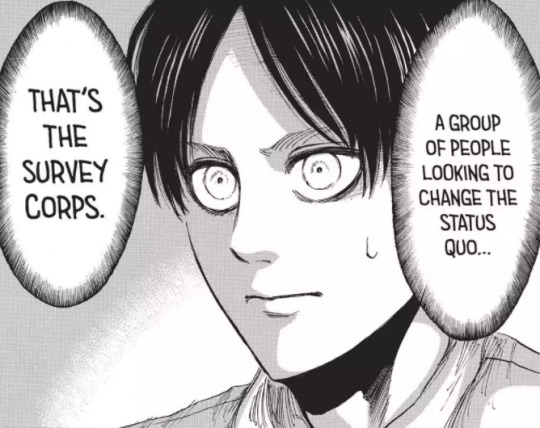
However, Eren was about to find out that things were far from glorious out there. Although the Survey Corps work under strict “plans” that soldiers are supposed to follow blindly, Eren can’t just watch people being sacrificed to protect him. Especially when he has enough power to act in a more significant way than those individual humans. But how much control does he have over his own power? Eren can’t answer that, and he feels immensely conflicted as soldiers continue to drop dead.
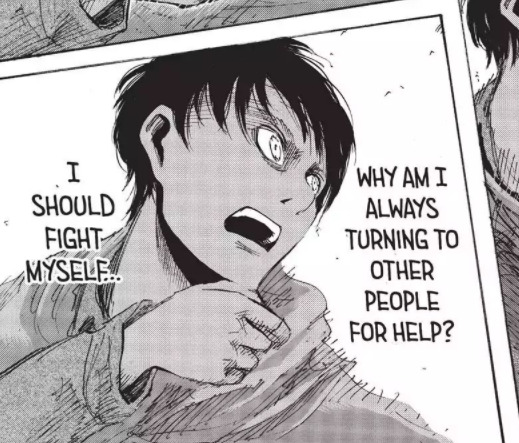
In that moment, Levi could’ve forced him to follow his orders, and perhaps that would’ve eased his mind when he chose not to transform. But the captain is a different kind of leader than Erwin, and he challenges Eren instead:

And I really appreciate how fitting that is to the type 6 conflit. It’s very difficult for them to accept it, sometimes there simply isn’t a clear path, sometimes it is okay to trust yourself and act on your own. But this is what Eren’s thinking:
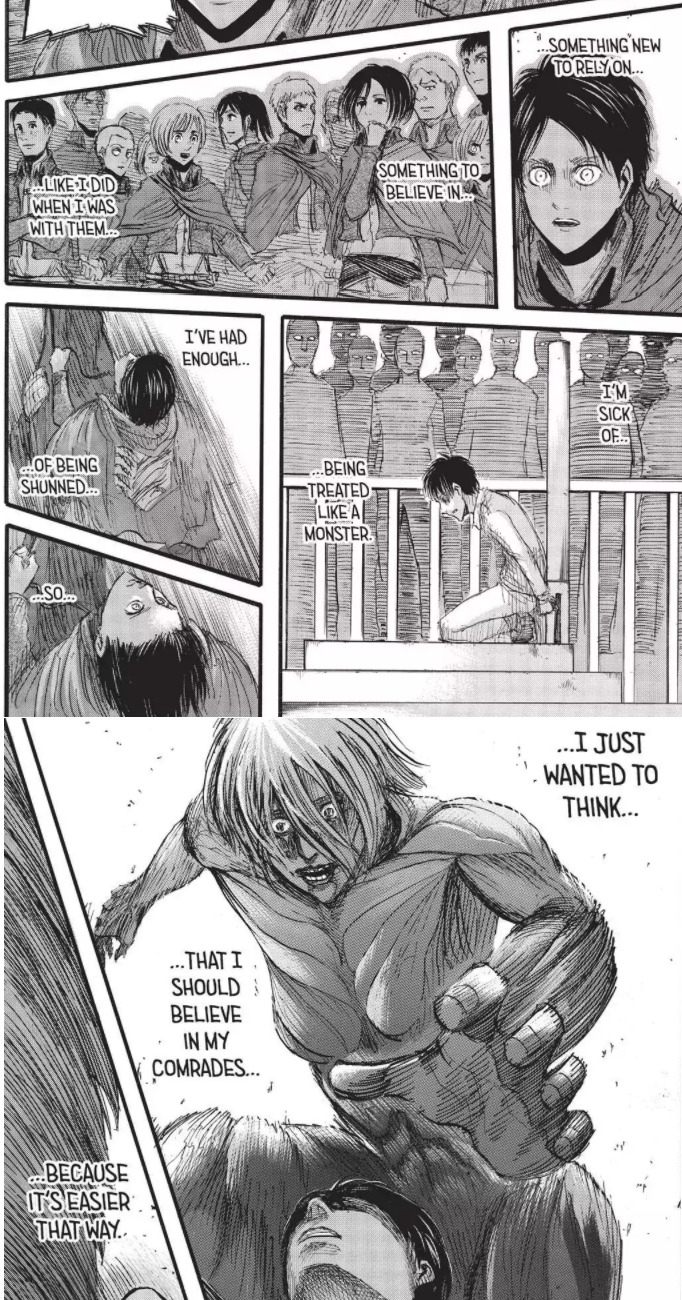
That didn’t turn out very well, did it? At the end of the expedition, Eren is forced to admit that the SC don’t have all the answers and that all his power and training can’t always keep everyone safe. He’s once again reminded of that after activating the Coordinate — not even the power to control titans can avoid sacrifices.
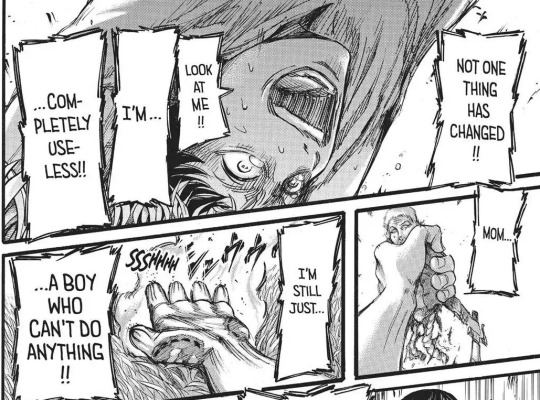
Ideally, the type 6 can only reach the safety they seek once they allow themselves to move in the chaos with the courage to face it step by step, instead of predicting it. This may sound easy for others but not for them, especially if they are inserted in a reality where the cost of a mistake is lives.
So we get to the Uprising arc. It starts with the Survey Corps planning the retake of Wall Maria while they put Eren through hardening experiments. Time is not on their side and Eren’s determined to go beyond his limits during the tests.
“They consequently try to further strengthen their ‘social security’ systems by working harder to be accepted and approved by their allies and authorities… Others wonder if they resent the workloads and pressures they seem to be under, yet Sixes seem eager to fulfill their obligations and duties...”

Eren’s entire world would fall apart again once he’s kidnapped by Rod Reiss and discovers the truth of his father’s sin. Like I said earlier, Grisha was one of Eren’s authority figures, and even though he was absent, the basement key and the promised truth kept son and father connected. Wherever Grisha was, Eren could still count on the answers he’d left behind.
That is, until he is hit by a trainwreck of a revelation that his father killed an entire family and sacrificed himself to pass on the titans to him. Eren’s left completely lost, he no longer knows what to think of himself, of the world, of his father.
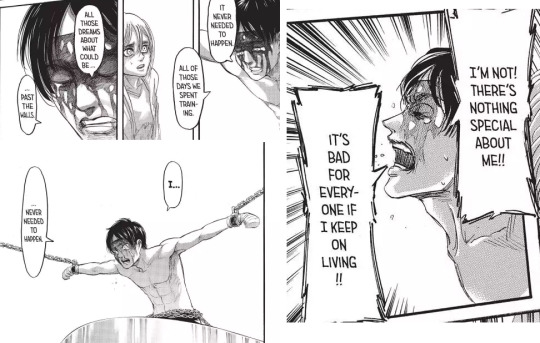
He falls from Level 4 to Level 7:
“Sixes become trapped in an unhealthy pattern of self-disparagement and massive insecurity which reinforces feelings of inferiority and worthlessness, a marked deterioration from the indecision and evasiveness we saw [before].”
This shift to a much more confused and self-loathing state doesn’t last long because Eren has his friend’s support for now. Historia chooses to see his worth and let him live. Levi once again challenges him to make his own decision, and Eren manages to save the day.

As Eren becomes aware of those destructive feelings, he tries to get rid of them by “fighting” himself, in an attempt to put himself back up.

He realizes he isn’t alone and he doesn’t have to do everything on his own, people around him are also strong enough to stand up for themselves. That helps him return to a more average stage and it could have been the beginning of his growth...

Well, if only life wouldn’t have a surprise waiting for him at every corner.
I hope you’re being able to follow and understand that we all have ups and downs in life. The levels of development represent exactly that, so it is common to find yourself in the same stage in different periods of your life. Nevertheless, after Eren learns the truth about the world and sees his future memories, it all goes downhill for him, no turning back anymore.

Here is what Riso comments on the ambivalence of the type 6 on Level 5:
“Sixes begin to follow the narrow path between the expectations of their allies and authorities and their need to resist having any further demands placed on them.”
Eren is overwhelmed by the view of the outside world. He has experienced his father’s memories first hand and it’s nothing like what he expected. No one around him has the same perspective. A lot of self-awareness and self-doubt emerge from the future memories he saw through Historia. Riso explains that on Level 5 the person starts to become more worried about how their allies feel about them.
“They become skeptical of new views and ideas, feeling that they have already put a lot of effort into understanding the perspectives and approaches they already know.”

Eren went from “I HATE TITANS ALL TITANS ARE MY ENEMIES DESTROY ‘EM ALL” to “titans are my people and they haven’t chosen this horrible outcome”. And that’s A LOT to process when you wrapped your life around that initial idea. But things are changing even faster, and his friends are talking about how the enemy could be reached out too. This thought needs to coexist in Eren with the clear image he has of the enemy, one that only he has accessed. Add to that how Eren was kept away from the Marleyan prisoners as Paradis also feared some kind of betrayal. As long as there’s people out there against them, he can’t so easily rest.
Who knows at what point Eren returns to Level 6. The time skip is covered very loosely. But probably when he is feeling so lost that he actually comes to Historia to vent.
“As in other types, to be functioning in this Level or lower usually indicates that there were extremely dysfunctional elements in the child’s environment.”
Self-explanatory. It’s even hard to talk about Level 6 because it is a point where Sixes start to overthink threats that aren’t that big, but in Eren’s case, the threat is 100% REAL and there’s a world isolating them and wishing for his people to die and throwing gigantic creatures at them. No big deal at all.

Eren turns to the people who actually understand the urgency he feels. Floch is eager to follow him, while Zeke and Yelena have an actual plan. Eren says he’s acting out of his own decisions, and he sure is, but he has also left it in Zeke’s hands to set the course. At this point, it no longer is a positive thing for the type 6 to have reassurance instead of a grounding support, it’ll only leave them trapped in the current mentality.
What would be more appropriate would be a balance between rejection…

…and full acceptance.

(By the way, I can’t even know where Historia stands, since she let him do his thing, but I’m still using her here because of how immediate her reaction was, which could lead Eren to think he can’t risk telling anyone else. Unhealthy Sixes are just that paranoid.)
Zeke could have been Eren’s new “authority figure“ if their goals were the same. But more and more the only thing Eren is starting to rely on are the future memories.
Riso talks about how a violent environment would lead to violent actions and “they end up using the same aggressive tactics on others”. And I can draw a parallel with how Eren has been facing titans for so long and watched them take people from him, that he just feels aggression arise whenever he thinks of all the injustice he has witnessed. Same would happen later on, when he sees Ymir’s memories and finally decides to unleash this pain on the world.

“It’s hard for Sixes to work for something. Instead, their energies are galvanized by being against people and things.”
Despite being highly conflicted and problematic, Eren so far has waited. It’s too hard at this point to fully engage with those dreams, but he has watched things unfold and allowed the Survey Corps to do their stuff and try to contact the outside world. On Level 7, the type 6 is just going through the day with little hope. When the SC reaches Marley and Eren meets the boy of his memories, he can no longer escape from facing himself.
“Tearful and obsequious, they are disgusted with themselves for not having been tough enough to stand on their own two feet, to defend themselves, to be independent.”
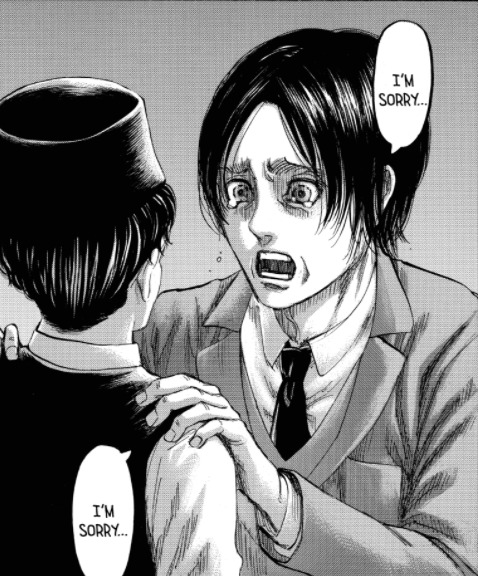
Not only Eren, but Paradis as a whole, have been unable to be independent in a much bigger world, or this is how he sees it after Kyiomi monopolizes the resources and the pro-Eldians group rejects the island. Finally, Eren recognizes in himself the person who would be capable of trampling the kid he currently wants to save, and that leaves him disgusted.
“They do not necessarily deceive others maliciously, but to escape punishment or abandonment. They believe they may be able to repair the damage they have caused...”
What Riso is saying here is that the type 6 feel the need to hide (themselves) so their loved ones won’t abandon them. And again, in Eren’s case, he has a damn good reason to think his loved ones might not be super happy if he said he was going to destroy the whole world. Let’s not forget they are the people who counted on him to save the world this whole time, and he is the person several people have been sacrificed for.
All this pressure has brought him this low, but Eren reaches rock bottom when he allows himself to admit he wished for it all to be destroyed. Now, he can no longer face his family (as he would tell Falco) and he has little faith in himself.
Again, Eren’s paranoias aren’t so far from reality because there is, indeed, a world against them, and that keeps feeding into his anxiety. Paradis’s progress is little and the future is uncertain. When the type 6 reaches Level 9, they can no longer get out of this spiral. They know it’s only a matter of time until the threat comes to them. So they call the threat upon themselves.


Eren allowed himself to go as far as understanding his enemies and accepting that they’re the same, but with the declaration of war, he can’t wait anymore.
I already told you the reason: the type 6 needs to be able to predict. That’s the very core of their beings, their minds seek to control events. Striking first is their final attempt to make sure they won’t be taken by surprise. Ultimately, they are lost and desperate to find support again. Here’s what Riso says about the type 6 on Level 9:
“They may drop out, abasing themselves as vagrants and living in skid row conditions, thus allowing their health and minds to deteriorate to the point of no return.”

It almost feels like Isayama has read this book, I swear to God. Yeah, that’s word by word what Eren does. He goes to enemy territory, injures himself and throws himself in war. Despite resisting for so long to a new perspective of his enemies, Eren allows himself to see them with his own eyes. All because he’s desperate to understand his enemy, desperate to understand himself (and what would lead to his decision) and desperate to run away from his friends. He is ashamed of choosing those future memories as his new authority figure, get it? They are the most certain thing in his life now. As much as he waited and as much as the SC tried, they don’t have any guaranteed future and it’s just too hard for the type 6, especially unhealthy Sixes, to wait. It’s impossible.
Remember I said that Sixes want to feel understood? Well, I think Eren feels understood, to some degree, when he’s among those broken soldiers. They are relatable, more than anyone else.
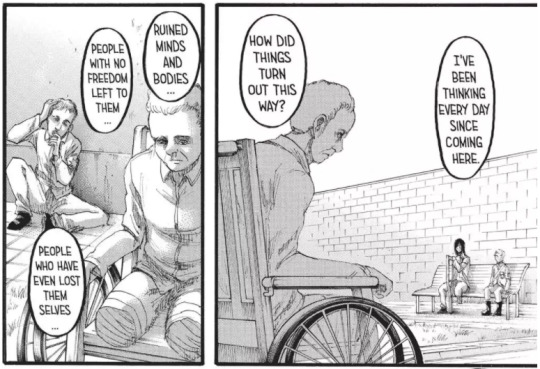
“Neurotic Sixes bring disaster of some sort upon themselves not to end their relationship with authority figures, but to reestablish a protective one. [...] It is also important to notice that neurotic Sixes are masochist not because they take pleasure in suffering as such, but because they hope their suffering will bring someone to their side who’ll save them… as if to say, ‘Punish me, because I’ve been bad. Then you can love me again.’”
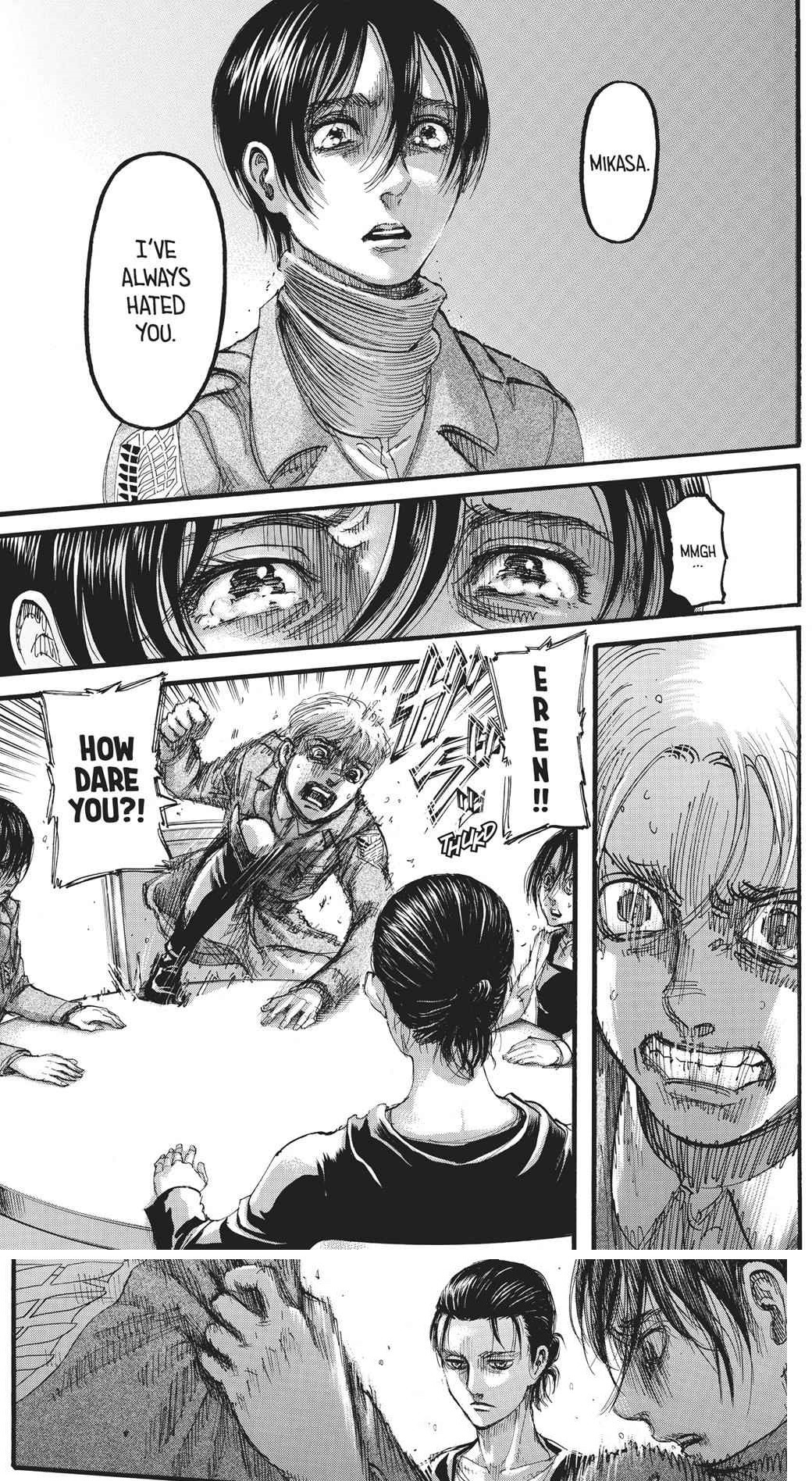
In the mind of the unhealthy type 6, if he can’t find the answers, he can’t be there for his allies. If he fails his allies, he doesn’t deserve their support. But even when he feels he doesn’t deserve it and feels they won’t forgive him, he desperately needs it — the type 6 doesn’t know how to live without support. He is completely aware of his cowardice, he may unleash his despair in innocent people, he seeks punishment for his behavior and hopes for someone to end his pain.
“Unhealthy Sixes are self-defeating persons who are their worst enemies. If they persist in their masochist behavior, neurotic Sixes will drive away everyone on whom they depend. They will be abandoned and alone, the very things they most fear.”
Eren pushed everyone away, but deep down he waited for them to come to his rescue. He knew he was a lost cause, but still couldn’t let go of what he saw as a compromise, a duty to them. His completely cruel and extreme actions are, in enneagram terms, his way to not leave his allies adrift. But aren’t all his actions for his own freedom? I don’t think so, not entirely. There’s a reason the type 6 has been named “the loyalist” — they always, always see themselves as part of a group. And in the end, he saw himself in Ymir, someone who was trapped and waiting to be rescued, understood. Don Riso says the worst part of coming this low is how much Sixes hurt others while they hurt themselves, both because they want to harm everyone who doesn’t understand and to show people the worst in themselves; they want to punish and be punished at same the time.

That is what I wanted to break down — Eren’s inner process. Yes, the type 6 is an ambivalent, contradicting personality type, precisely because that’s how they feel inside. Other enneagram types don’t escape from their own personal conflicts, that’s also important to point out. The enneagram does not define integrity, people capable of causing great harm exist in all types and no one from type 6 is fated to destroying the world — just in case that isn’t obvious.
This post is heavy, I know. One of the things I love about SNK are the emotions it evokes and how human characters are. I’m so thankful to have followed Eren’s fascinating journey. He has never hit me as a one-dimensional character as some people claim. To me, Eren is not a chad, he’s not a monster, either. He’s just human.
I’m thankful for this fandom as well. We’re a total mess but the monthly wait would’ve killed me without the crazy theories and the heated discussions.
#snk 137#snk 138#snk 139#Eren Jaeger analysis#attack on titan manga and anime#enneagram#LONG post#eren jaeger#snk analysis
58 notes
·
View notes
Note
a lot of the tommy privs are follow now are bringing up a current streak of bad behavior. apparently there was an incident in amsterdam where he threw a tantrum over someone taking his bottle of head and shoulders shampoo (when there was another bottle) & went on a tirade against everyone trying to figure out who took it and demanding it back to the point jack had to yell at him to make him stop? mentioned on the ylyl stream with molly who went: “you didn’t just give it to him?” & well as making jokes about p*ppytwt and how people made art of him as a minor in call with tubbo and piso during mcc and they both got triggered by it and deafened and in his new video he compared himself to james charles
the last two i can get as him trying to be edgy / force the mature label onto himself so he isn’t seen as a kid for better or for the definite worse, but really can’t figure out a good analysis of the first one other than Oh Wow
would love to get your opinions
https://youtu.be/oUUVoob-aIw?si=UBTRzhQA1Z4J_T13 23:58 amsterdam story for reference
Oh okay I’ve missed out on way more than I thought, damn. MCC is usually too big for me to digest but if someone is willing to do up a timestamp I could check the energy out.
One of Tommy’s engines is counterphobia, which is the compulsion to move towards things that make him uncomfortable or scare him in order to get a handle on them. He also tends to lean into this more when adrenaline hits him, so when he gets messy he really starts nipping. The thing is, I think his adrenaline / panic response has been really hitting hard between his self-admitted depression and working out the genuine trauma of his teen years, so he’s riding the highs and lows.
I’ve sat with this for a bit but Tommy is very into material signifiers of safety, and he always has been. (If I was being dorkier about the enneagram in this post I would cave in and finally call him a Self-Preservation (SP) Six since those are the most concerned with food/water/shelter/physical comfort.) He’s very sensitive about money, comfort, space, just anything you can point to and touch and count. On the more abstract level he’s very into numbers and making those numbers bigger. On the inverse, he cannot seem to handle the loss of those things well. I have to wonder if there’s a specific trauma there, or if it’s just his default nature. I know people like to say it’s because he’s an only child, but even only children can learn after a while.
Tommy needs mentors and examples for how to do things in life, and now he’s gone and made his life deeply unique to himself, which means that nobody can 'fully' mentor him (on top of how shady the entertainment scene is-- paranoia sits badly in him), and he has to figure things out himself while gathering bits and pieces where he can. For a psyche like his, this is not a great deal, especially not for his still-formative years. He’s going to have to feel a lot of things out himself, and that means an incredible amount of trial and error, in potentially dangerous amounts depending on what his choices are.
#no new-new updates from me unfortunately#Also just watched the minecraft video and I’m jotting down the 'addiction' aside#Because that sounded just bold enough to be real#And does not do any favors to the whole ‘internal emotional regulation’ thing if it is#gen tmmy tag#tmmy 6w7
11 notes
·
View notes
Text
Hello!
I am the ENFP who asked you about the enneagram recently. I am investigating the possibility that I may be a 9. I read that its core fear is conflict, but I sometime read about the fear of loss and separation. Which one would be the real one? I relate very much to the fear of separation and loss (of relationship mainly) but I don't see how it could be a manifestation of the famous "sloth" (as you have to go toward people to maintain relationships). How is it different from the fear of being unloved or unwanted?
The "sloth" referenced as regards 9 is not about laziness, but slowness to spiritually develop oneself as separate from others; slow to leave one's comfort zone, enact change in their life, and attack life with the ferocity of the other types. It's a spiritual and psychological sloth born of contentment with living within your comfort zone. What does this mean in layman's terms? "Getting a better career requires too much work, that would make me uncomfortable and anxious, so I'll just stay in this one." "Pursuing that person romantically might introduce me to uncomfortable feelings of rejection or shame... I don't want to face those, so I'm fine the way I am." "I'll get around to it." "This person hurts my feelings a lot, but breaking up with them would upset them, and that would upset me, so I won't. I'll just stick it out."
9s hate change and don't like having things ripped away from them, because it introduces a bunch of emotions and feelings they would rather not feel -- it introduces an "upset" into their "calm." Their desire is to maintain an inner state of calmness at all times, which means tuning out whatever they do not like or that makes them feel anxious, so they can calmly go about their day doing what they like. But this disconnect also means being easily distracted, because they aren't really tuning in to reality; they're creating a cloud around themselves and living in it, where nothing can quite penetrate them.
I also read about enneagram countertypes (who would have different behaviours compared to the usual manifestation of the enneatype). For example social 9 could mistype as 3 or 7? What do you think about this theory.
I think countertypes are nonsense, other than cp6, and even there, all 6s have degrees of phobia and counterphobia. Countertypes are often used as an excuse to mistype, along with tritype ("I am this, but 90% of it doesn't quite fit me, but that's okay, because I'm a social/sexual/8-fixer/4-fixer/5-fixer...").
As much as I relate to the 9 core fear (I relate also to the 2, 3, 7 and 8 core fears) <- relating to everything pretty much proves 9, since the 9 has attributes of all the types and merges into all the types.
), and even if I daydream a lot when confronted to tedious tasks (drifting away is easier than being present to that kind of things) <- 9 trait.
, I always have been very proactive in my life and prone to overlook rest. <- what can you use as an explanation for this? That you are sp/so? That you are a 9w8? That you are an J type? Look at everything like a puzzle and see how it all fits together.
Moreover, even if I perceive myself as soft and agreeable, people seem to always have seen some kind of aggression and intensity in me. A friend who never saw me angry once told me that in a hunter gatherer society I would definitively be a hunter. I have trouble conciliating how I think, how I act and how I am perceived, hence my questions.
I know an sp/so ISFJ 9w1 who is passive a lot of the time, but you make her mad and you'd better watch out. She is fierce when you rile her up and would be extremely proactive in protecting her loved ones and ensuring she has enough resources for them. So, your MBTI type, your stacking, and your core do matter.
Thank you very much, and congratulations on your book!
Thanks. :)
18 notes
·
View notes
Text
I was very single-track minded in my appointment today.
But intrusive thoughts got brought up by me thanks to the episode.
And I’ve basically ID’d a few flavors of it in myself:
Negative self-talk / core beliefs - “nothing I do is enough“. I’m better at challenging it nowadays than in the past. Sometimes you gotta remind yourself that you’re doing your best.
Trauma flashbulbs/flashbacks. Self-explanatory. Unpleasant but not unexpected experiences. Completely understandable after That Shit. Another reason for self-compassion.
“Forbidden Candy” thoughts while handling my dad’s meds. No, those are not Mike & Ikes nor Smarties... Do Not Eat. You don’t even like those candies much, anyways. No less amusing to myself here.
Intrusive horrific/gory imagery (not often... but often used it for artistic inspo after initial shock/disturbance subsides.)
This all to say, more reasons why I like Remus as much as I do.
Like. One of my own draws to horror is counterphobia - deliberately going toward the stuff that gives you fear and anxiety and coming to terms with ‘em (in a safer and more manageable way).
(Hell, I’m prone to hypochondriac thinking and I love body horror.)
#sanders sides#remus sanders#(i am yet again really wanting to put this in the IT tag because i'm using fandom as a means of expressing/analyzing them)#(just another part of how my brain just operates man)#(that self-talk bit? yeah. that's one reason i love roman angst)#('cause i'm all too familar w/ tearing myself down)
5 notes
·
View notes
Text
Barely any videos about people falling from super high places.
2 notes
·
View notes